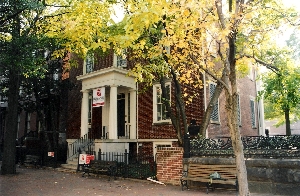
Modern Transportation for the Virginias
 |
| Photo courtesy of Steve Dunham, |
The Virginia Association of Railway Patrons held its annual meeting on
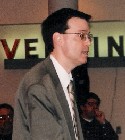 |
Page began the meeting by presenting the department’s study of the Richmond area. He said that the commonwealth is still studying “higher”-speed rail for the Southeast Corridor, a proposed intercity passenger trunk line south of Washington, DC. The earliest the state could see any high-speed rail construction is 2010. The Hampton Roads study was suspended until Amtrak committed to keeping the Federal (the southbound morning, northbound evening train between Washington and Newport News). The department’s study of the Hampton Roads area considers both the north and south sides of Hampton Roads.
Mr. Page’s presentation
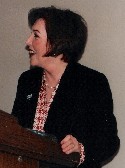 |
The commonwealth’s decision to emphasize the Richmond line of the Trans-Dominion Express for possible implementation meant that Charlottesville would not get more train service for a long time. C’ville (Charlottesville) Rail was organized to get more train service than is provided by the Crescent (often sold out) and the Cardinal (less than daily and often late). To get support from other cities and counties that would benefit from another passenger train, C’ville Rail was expanded into the Piedmont Rail Coalition. The coalition includes
Virginia’s transportation funding goes mostly to highways (79%), less than one-sixth for transit (15%) and almost nothing for intercity rail. A new Piedmont train could be funded for about
Ms. Richards’ presentation
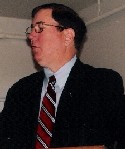 |
Norfolk is the smallest city in the United States to build light rail. The project received a full funding grant agreement from the Federal Transit Administration in February 2007, and groundbreaking was in December. The system should begin operating in January 2010. It took a lot of work to get FTA approval. The city persuaded FTA administrators Dorn, Bushue, and Simpson (in succession) to visit Norfolk and see what was planned. Bushue met with business leaders. In July 2007, Norfolk hosted an American Public Transportation Association conference, bringing more interested people to visit the area.
Winning FTA approval required many changes from the original concept of the project. The FTA considers cost per rider, cost per mile, and other measures, but the standards keep changing.
Rather than build more highways within the city, Norfolk is using highway construction funds to pay for its share of the project funding.
Norfolk expects a return on its investment, estimating that $1 invested in rail transit yields $3 to $5 in private development. Property near the light rail system constructed in Dallas went up 53% in value.
The system is using the same light rail vehicle as Charlotte, NC. Learning from Baltimore’s experience, the Norfolk system will have no single-track stretches.
Nearly all transit systems in the United States have plans for expansion, and Norfolk intends that once its initial line is operating and meeting or exceeding expectations, the next additions to the system would be lines to the naval base and Norfolk State University. Hampton Roads Transit is looking at establishing express bus routes to connect the light rail line with the airport and Virginia Beach Town Center.
Mr. Wright’s presentation
 |
Legislators in Richmond are followers, not leaders. They will respond to public pressure. A trip to the Northwest to see some urban public transit systems in action opened some of their minds to the benefits of rail transit, and climbing gas prices will increase public demand for passenger rail. Congestion, the growing population of elderly and disabled people, and climate change are fueling the push for public transportation.
The Virginia Transit Association is seeking these things:
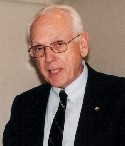 |
The railroad is used by Amtrak’s Cardinal, and the railroad needs money to provide better track for the Cardinal. Amtrak revenue (($375 per train, $117,000 in 2007) doesn’t cover the Buckingham Branch’s costs of hosting it or justify the track and signal work needed. The Buckingham Branch Railroad got only $200 for an Auto Train detour. The track inspector who preceded the train in a hi-rail vehicle cost more than that.
The Buckingham Branch Railroad had
The railroad got an award for promoting passenger service: it runs
The railroad must maintain leased CSX track and signals (besides the Buckingham Branch’s own property).
Bryant didn’t want to take state money, but accepted a grant for ties when the Buckingham Branch Railroad first started, because he had a vision—a vision of its only diesel falling into the James River.
Dick Beadles, founder of Virginians for High Speed Rail and former president of the Richmond, Fredericksburg & Potomac, commented that the Buckingham Branch Railroad exhibits prudence and good business sense.
The railroad has improved the track and has a six-year plan to improve it more. Tie and ballast work is under way. It has put a passing track back into service.
It doesn’t like to use contractors for maintenance-of-way work. They cost about three times more than railroad labor, and they want stretches of the railroad shut down to accommodate their work, whereas the railroad can schedule its own employees to work in between train movements.
One thing he is fearful of is motorists: they drive around the gates and drive into trains.
The following members were unanimously reelected to the board: Jim Bayley (Virginia congressional
Steve Dunham was reelected chairman; Mike Testerman, president; Jim Churchill, executive vice president; Dick Peacock, secretary; Herbert Richwine, treasurer; and Allan Carpenter, assistant treasurer.